White Cloud Mountain Minnow
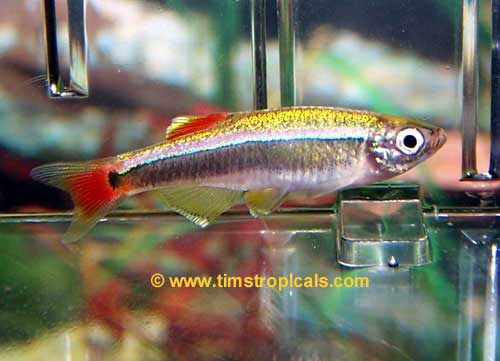
White Cloud Mountain Minnow
The White Cloud or White Cloud Mountain Minnow originally came from China. The body has a greenish background with golden zones along the main line of the body. There are red spots on the fin tips, especially on the caudal fin. The Gold White Cloud is a color variation where the body is a more solid silvery golden color while the fin tips remain reddish.
White Cloud - Aquarium Setup
Although White Cloud Mountain Minnows are compatible with other freshwater tropical fish, care must be taken with the temperature range. Most tropical fish require a heater to ensure temperatures stay in the mid 70s, but this is the top of the range for the White Cloud. White Clouds can do quite well in a fish bowl or unheated aquarium. They should be kept in schools.
White Cloud - Breeding
Males and females are difficult to distinguish, but easy to breed. The males are somewhat longer and more colorful. The water should be at the warmer end of their range. Eggs are scattered over a number of days. After spawning, remove the parents. Feed the fry brine shrimp.
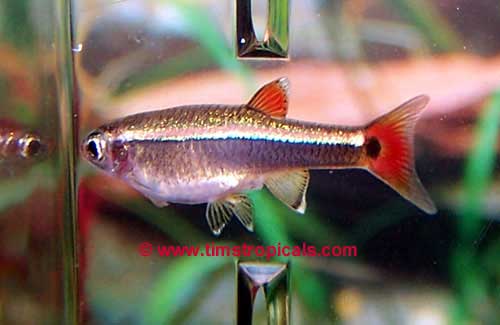
White Cloud Mountain Minnow
White Cloud - Compatibility:
The White Cloud Mountain Minnow is compatible with Black Phantom Tetras, Cardinal Tetras, Chinese Algae Eaters, Ghost Shrimp, Glow Light Tetras, Guppies, Harlequin Rasbora, Mollies, Neon Tetras, Plecos, Platies
White Cloud - Profile
-
Scientific Name: Tanichthys albonubes
-
Family: Cyprinid
-
Temperature: 13 - 24 C; 55 - 75 F
-
pH: 7.2
-
Size: 4 cm; 1.5 inches
-
Life Span: 5 - 7 years
-
Breeding: Easy, Egglayer
Harlequin Rasbora
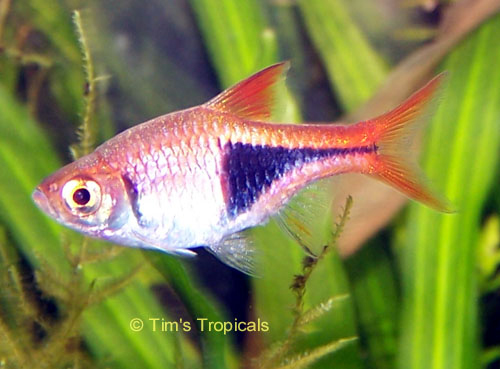
Harlequin Rasbora
The Harlequin Rasbora is fairly popular, because it is a hardy community fish that can tolerate variations in pH levels. It originates from the Thailand and Malaysia area. It has a pinkish body with a black triangle filling most of its back half. It likes lots of plants and dim lighting, which actually helps enhance its color. Harlequin Rasbora should be kept in schools of 8 - 10.
Harlequin Rasbora - Breeding
Females are slightly larger than the males. For breeding Harlequin Rasbora spawn eggs on the underside of broad leaves and surfaces. After spawning, remove the parents and keep the aquarium dark until the eggs hatch a day later. Feed the Harlequin Rasbora fry infusoria or brine shrimp.
Harlequin Rasbora - Compatibility:
Harlequin Rasbora are compatible with Black Phantom Tetras, Cardinal Tetras, Catfish, Chinese Algae Eaters, Ghost Shrimp, Glass Fish, Glow Light Tetras, Guppies, Honey Gouramis, Neon Tetras, Plecos, one Red Tailed Shark, White Cloud Mountain Minnows
Harlequin Rasbora - Profile
-
Scientific Name: Trigonostigma heteromorpha
-
Family: Cyprinid
-
Temperature: 22 - 25 C; 72 - 77 F
-
pH: 6.5
-
Size: 5 cm; 2 inches
-
Life Span: 2 - 5 years
-
Breeding: Difficult, Egglayer
Green Eyed Rasbora
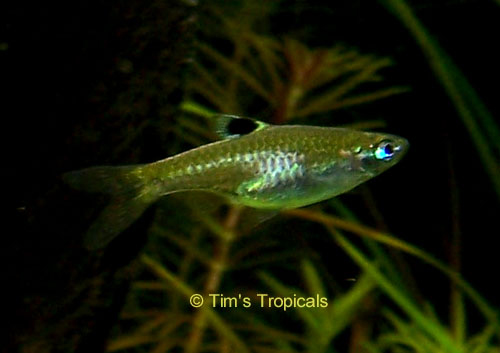
Green Eyed Rasbora
Gardneri P82 Killifish
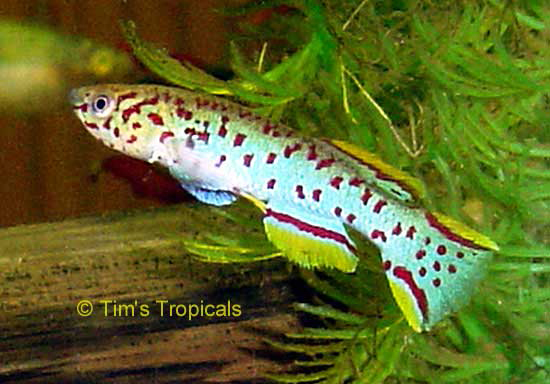
Gardneri P82 Killifish
Thanks to Lemuel Martinez from Puerto Rico for the following information:
Killies are often referred as annuals fish, because some species live in waters that run dry. Before dying, they leave their eggs to re spawn as soon there's water again. But make no mistake, they die only because water runs out. In our tank conditions they will live more than that. Like any other fish out there, there are many species of them that are not annuals and have the same colorful characteristics. And guess what, some can kept by beginners! So lets start.
The American Killifish Association (AKA) separate Killies in 5 groups:
Aphyosemion (not annuals, many suited for beginners).
Fundulopanchax (not annuals, many suited for beginners).
Epiplatys (not annuals, many suited for beginners) these ones are surface fishes.
South American Annuals (Annuals).
Nothobranchius (Annuals) some say they are the most beautiful fish on Earth.
Gardneri Killifish - Feeding
This fish requires little space (pairs are kept in 5 to 10 gallon tanks), but this is solely used because of breeding, not because they are incompatible with normal fishes. They require that the tank has a filtration system or at a minimum, an air pump. Make sure the tank is covered as they are good jumpers. If you are looking to keep a small tank with gorgeous fish, this would be your choice. Females are not as beautiful. Killies are carnivores, but will eat anything. Their color will fade a lot if fed only with flakes. Most people recommend to feed them with different kinds of food and live food will benefit them the most.
Gardneri Killifish - Breeding
The only compatibility problem is that they will eat smaller fishes (that's why most people have the smaller Killies and males are aggressive upon males of the same species. Most Killis have a small mouth so shouldn't be a major problem. One excellent idea would be having a pair of Killies in a 10 or 20 gallon tank, heavily planted. You can have them reproduce there, specially many species of Aphyosemion and such species as Epiplatys annulatus. This species, like some others, don't require to their eggs to be removed from water. Perfect!
Gardneri Killifish - Buying
Water parameters, such as pH and salinity depends on each Killie, so a little more research is needed before buying. Be aware that some people sell the eggs instead of fish. Eggs don't always hatch easily, so try the fish first. Eggs are less expensive, but not necessarily a better deal. Killies are rare in pet shops, but every now and then are available. So this can help you a little if suddenly you find yourself in the store with a Killie, believe me, they are hard to resist. Most are hard, strong fish, but if you plan to have them for years to come, like 5 or more years, you will have to reproduce them (anyway, reproducing fish is never a bad idea, especially Killis). Hope this helps.
Gardneri Killifish - Compatibility:
Gardneri Killifish are compatible withAngelfish, Corydoras, Danios, Discus, Dwarf Gouramis, Hatchetfish, Livebearers, Plecos, smaller Tetras
Gardneri Killifish - Profile
-
Scientific Name: Fundulopanchax gardneri
-
Family: Cyprinid
-
Temperature: 22 - 25 C; 72 - 77 F
-
pH: 6.0 - 7.0
-
Size: 6.5 cm; 2 inches
-
Life Span: years
-
Breeding: Easy, Egglayer
Golden Wonder Killie
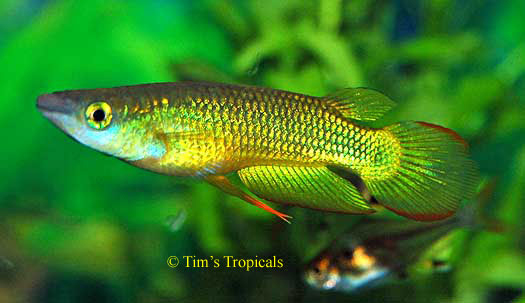
Golden Wonder Killie
Lyretail Panchax
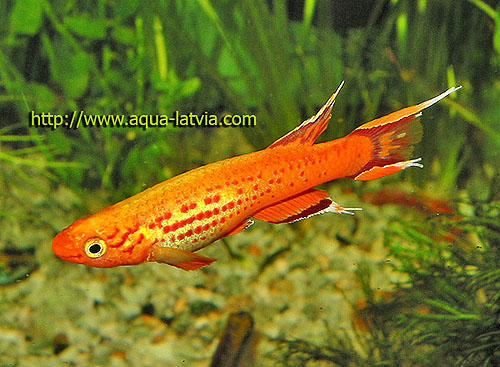
Lyretail Panchax
Zebra Danios and GloFish

Zebra Danio is a favorite beginner fish because it is hardy and easy to breed. Zebras originally came from India. They have uniform horizontal stripes along the entire length of their body. They are rapid active swimmers and should be kept in schools of at least 6. Zebras eat standard flake foods, but also like freeze dried bloodworms and brine shrimp.
Zebra Danio - Breeding
Males have thin bodies, while females are larger and broader. The belly on the female is white and very large when laden with eggs. A separate tank is one alternative for breeding. Marbles make an excellent substrate, as it will keep the parents from eating the eggs. Eggs are scattered over the entire surface of the bottom of the tank. After spawning, remove the parents. Feed the fry brine shrimp.
Another way to breed danios is to maintain several females and even more males in a tank. Watch them carefully for breeding activity. They will tend to spawn in the early morning after the day of a water change. They will travel rapidly in a group around the bottom of the tank. Once eggs have been released, the females tend to move to the upper levels of the tank, while males will swim excitedly about the bottom. Males will eat eggs that are stirred up off the bottom by all their activity. Another indication of a spawn of eggs is other fish from the upper tank levels, such as livebearers, feeding off the bottom. At this point, siphon the bottom of the tank and fill a bucket. Let the bucket water sit at room temperature for a couple of days and wait to see if any fry hatch. If they do, proceed to our section on Feeding Fry.
Zebra Danios - GloFish
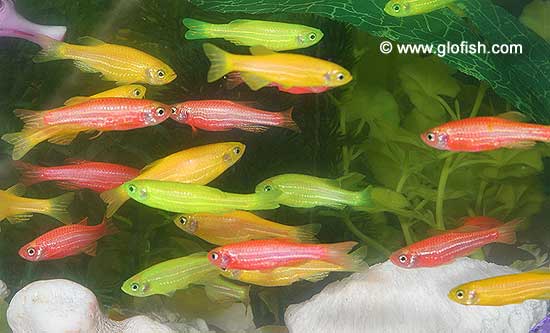
GloFish
GloFish are Zebra Danios that have been genetically altered by introducing the DNA of a sea anemone. GloFish are have been produced in red, yellow and green, but colors are often faded compared to online pictures. Check carefully because GloFish are not prohibited in some states and countries.
Zebra Danio - Compatibility:
Zebra Danios are compatible with Catfish, Chinese Algae Eaters, Clown Loaches, Gouramis, Mollies, Platies, Plecos, Rainbows, one Red Tailed Shark, Swordtails
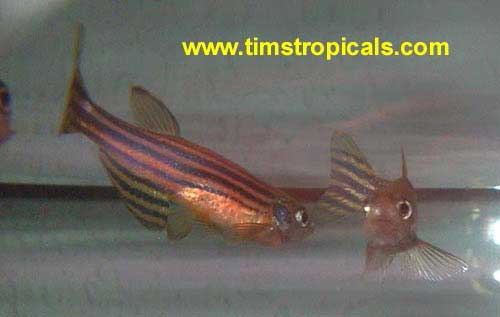
GloFish
Zebra Danio - Profile
-
Scientific Name: Danio rerio
-
Family: Cyprinid
-
Temperature: 18 - 28 C; 64 - 82 F
-
pH: 6.0 - 8.0
-
Size: 6 cm; 2.5 inches
-
Life Span: 5 - 7 years
-
Breeding: Easy, Egglayer